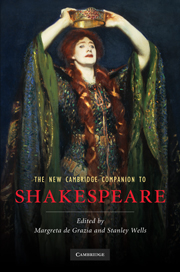Book contents
- Frontmatter
- 1 The traces of Shakespeare’s life
- 2 Shakespeare’s reading
- 3 Shakespeare’s writing: from manuscript to print
- 4 The theatre of Shakespeare’s London
- 5 The transmission of Shakespeare’s texts
- 6 Shakespeare and language
- 7 Shakespeare the poet
- 8 Shakespeare’s comedies
- 9 Shakespeare’s tragedies
- 10 Shakespeare’s English history plays
- 11 Shakespeare’s classical plays
- 12 Shakespeare’s tragicomedies
- 13 Shakespeare, religion and politics
- 14 Shakespeare and race
- 15 Shakespeare, sexuality and gender
- 16 Shakespeare on the stage
- 17 The critical reception of Shakespeare
- 18 Shakespeare and popular culture
- 19 Shakespeare and globalization
- 20 Shakespeare and media history
- 21 Shakespeare: reading on
- Index
16 - Shakespeare on the stage
Published online by Cambridge University Press: 28 January 2011
- Frontmatter
- 1 The traces of Shakespeare’s life
- 2 Shakespeare’s reading
- 3 Shakespeare’s writing: from manuscript to print
- 4 The theatre of Shakespeare’s London
- 5 The transmission of Shakespeare’s texts
- 6 Shakespeare and language
- 7 Shakespeare the poet
- 8 Shakespeare’s comedies
- 9 Shakespeare’s tragedies
- 10 Shakespeare’s English history plays
- 11 Shakespeare’s classical plays
- 12 Shakespeare’s tragicomedies
- 13 Shakespeare, religion and politics
- 14 Shakespeare and race
- 15 Shakespeare, sexuality and gender
- 16 Shakespeare on the stage
- 17 The critical reception of Shakespeare
- 18 Shakespeare and popular culture
- 19 Shakespeare and globalization
- 20 Shakespeare and media history
- 21 Shakespeare: reading on
- Index
Summary
The actor
The most important element that distinguishes Shakespeare on the stage from Shakespeare on the page is the presence of the living actor. Shakespeare was well aware of this; he built into his plays an extraordinary attentiveness to the physical being of the actor, or, to be more precise, the actor/character. The body on the stage belongs to the actor but is in a sense the character as well. At the end of King Lear, for example, the distraught king and father carries the dead body of his daughter Cordelia on stage. He is an old man ('four score and upward') and she a mature woman. It is no easy feat to carry her (here our awareness of the actor's burden may very well cross with our sense of the character's). But her very weight is part of the point - a physical manifestation of the burden of pain that so many of the people on stage have at this point to shoulder, Lear more than any other. He lays her down, mourning her fate. Briefly he revives, hoping for, perhaps believing in, a reprieve from all this pain: 'This feather stirs; she lives!' For a moment he seems to believe she breathes, but then distraction takes over as the others try to speak to him.
- Type
- Chapter
- Information
- The New Cambridge Companion to Shakespeare , pp. 233 - 252Publisher: Cambridge University PressPrint publication year: 2010

